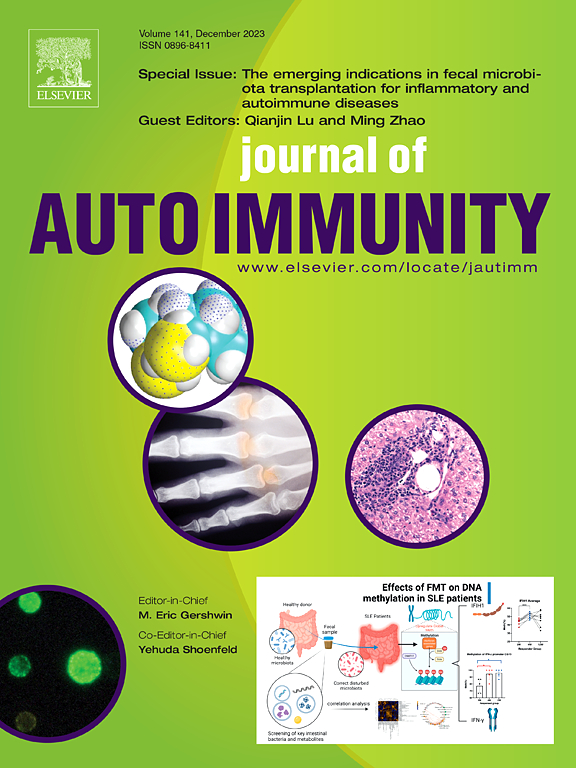自身免疫性疾病和炎症性疾病终生和当前合并症模式的临床相关性。
IF 7.9
1区 医学
Q1 IMMUNOLOGY
引用次数: 0
摘要
背景:自身免疫性和炎症性疾病(AIDs)是一类具有不同致病机制的异质性疾病。本研究探讨了家族史以及现在和过去的合并症在识别不同病因亚组方面的潜在作用。这种方法可能有助于更准确的诊断、预后和个性化治疗:方法:我们对患者的合并症进行了多重对应分析,然后对 48 名健康志愿者和 327 名在 TRANSIMMUNOM 横断面研究中 19 种选定艾滋病中至少有一种的患者的临床数据进行了分层主成分聚类:我们发现了三个不同的群组,其特征如下1) 无合并症;2) 多自身免疫;3) 多炎症。这些群组还根据具体的合并症和生物参数作了进一步区分。自身抗体、过敏和病毒感染是多自身免疫群组的特征,而高龄、体重指数、抑郁、癌症、高血压、牙周病和血脂异常则是多炎症群组的特征。类风湿性关节炎患者分布在所有三个群组中。在多炎症群组和多自身免疫群组中,类风湿性关节炎患者的DAS28和关节外表现患病率较高,而在多炎症群组中,类风湿性关节炎患者的ACPA和RF血清阳性率较低,疼痛评分较高。我们建立了一个模型,可将艾滋病患者划分为合并症群组:在这项研究中,我们在艾滋病患者中发现了三种不同的合并症特征。结论:在这项研究中,我们在艾滋病患者中发现了三种不同的并发症特征,这些特征表明这些亚群存在不同的病因机制。要全面了解这些特征在个性化医疗中的潜在作用,还需要进行验证、纵向稳定性评估,并探索它们对治疗效果的影响。本文章由计算机程序翻译,如有差异,请以英文原文为准。
Clinical correlates of lifetime and current comorbidity patterns in autoimmune and inflammatory diseases
Background
Autoimmune and inflammatory diseases (AIDs) are a heterogeneous group of disorders with diverse etiopathogenic mechanisms. This study explores the potential utility of family history, together with present and past comorbidities, in identifying distinct etiopathogenic subgroups. This approach may facilitate more accurate diagnosis, prognosis and personalized therapy.
Methods
We performed a multiple correspondence analysis on patients' comorbidities, followed by hierarchical principal component clustering of clinical data from 48 healthy volunteers and 327 patients with at least one of 19 selected AIDs included in the TRANSIMMUNOM cross-sectional study.
Results
We identified three distinct clusters characterized by: 1) the absence of comorbidities, 2) polyautoimmunity, and 3) polyinflammation. These clusters were further distinguished by specific comorbidities and biological parameters. Autoantibodies, allergies, and viral infections characterized the polyautoimmunity cluster, while older age, BMI, depression, cancer, hypertension, periodontal disease, and dyslipidemia characterized the polyinflammation cluster. Rheumatoid arthritis patients were distributed across all three clusters. They had higher DAS28 and prevalence of extra-articular manifestations when belonging to the polyinflammation and polyautoimmunity clusters, and also lower ACPA and RF seropositivity and higher pain scores within the polyinflammation cluster. We developed a model allowing to classify AID patients into comorbidity clusters.
Conclusions
In this study, we have uncovered three distinct comorbidity profiles among AID patients. These profiles suggest the presence of distinct etiopathogenic mechanisms underlying these subgroups. Validation, longitudinal stability assessment, and exploration of their impact on therapy efficacy are needed for a comprehensive understanding of their potential role in personalized medicine.
求助全文
通过发布文献求助,成功后即可免费获取论文全文。
去求助
来源期刊

Journal of autoimmunity
医学-免疫学
CiteScore
27.90
自引率
1.60%
发文量
117
审稿时长
17 days
期刊介绍:
The Journal of Autoimmunity serves as the primary publication for research on various facets of autoimmunity. These include topics such as the mechanism of self-recognition, regulation of autoimmune responses, experimental autoimmune diseases, diagnostic tests for autoantibodies, as well as the epidemiology, pathophysiology, and treatment of autoimmune diseases. While the journal covers a wide range of subjects, it emphasizes papers exploring the genetic, molecular biology, and cellular aspects of the field.
The Journal of Translational Autoimmunity, on the other hand, is a subsidiary journal of the Journal of Autoimmunity. It focuses specifically on translating scientific discoveries in autoimmunity into clinical applications and practical solutions. By highlighting research that bridges the gap between basic science and clinical practice, the Journal of Translational Autoimmunity aims to advance the understanding and treatment of autoimmune diseases.
 求助内容:
求助内容: 应助结果提醒方式:
应助结果提醒方式:


